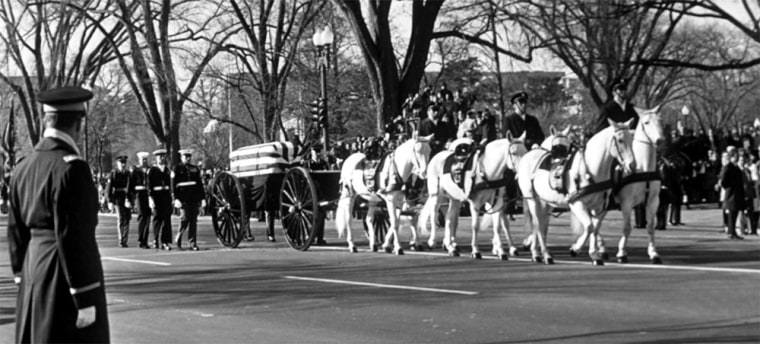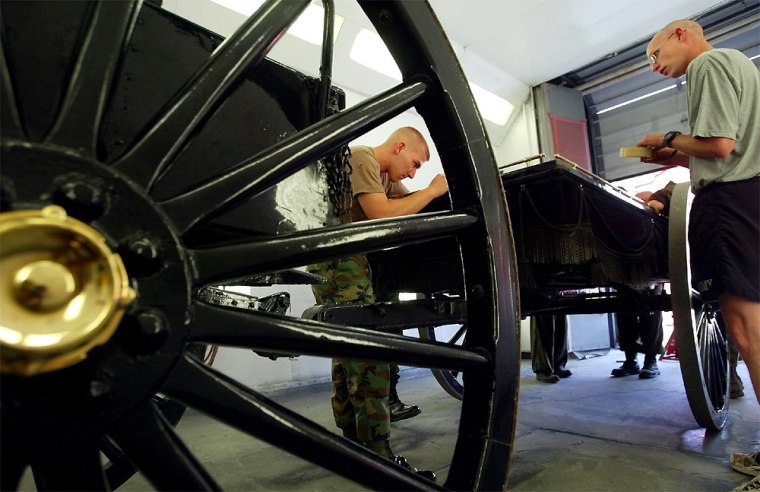For the soldiers of the 3rd U.S. Infantry Regiment, the state funeral Friday for former President Ronald Reagan will be most important duty of their military careers, the ultimate expression of the pomp and ceremony for which they have been expressly trained.
The ceremonial guard companies of all four major military services will take part in the funeral proceedings Friday in Washington, for which the Marine Corps Air Ground Combat Center Band will provide music. But it is the 3rd Infantry Regiment, known as the Old Guard, that is in charge by law. Its soldiers are responsible for bringing off the ceremony flawlessly.
The Old Guard, based at Fort Myer, Va., near Arlington National Cemetery, is in charge of all state funerals, to which all former presidents are entitled. But there has not been a full state ceremony for a former commander-in-chief in the nation’s capital since Lyndon B. Johnson was honored in January 1973.
(It has been a point of some confusion this week, but officials with the Military District of Washington and the Richard Nixon Library and Birthplace in California said Nixon did receive a state funeral in 1994. At the family’s request, however, the ceremonies were held in the former president’s hometown of Yorba Linda, Calif., not in Washington.)
Formal rules for how to conduct a state funeral are set out in a 134-page Army manual, but the traditions are usually adapted to accommodate the wishes of the family. The former president’s widow, Nancy, has consulted with military officials annually since Reagan left office in 1989, according to the Ronald Reagan Library.
Ever-present, standing guard
Formal military honors began Monday, when all Army installations offered one-gun salutes for one day every half-hour beginning at reveille and ending at retreat, a custom reserved for the death of the president or a former president. But the Old Guards themselves have been with Reagan’s body almost from the moment his death was announced on Saturday.
They stood vigil as the former president lay in repose Monday and Tuesday at the Ronald Reagan Presidential Library in Simi Valley, Calif.

They coordinated the funeral procession Wednesday in Washington, as the former president was borne from Andrews Air Force Base to the White House, where he was transferred to a horse-drawn caisson for the slow procession along Constitution Avenue to the U.S. Capitol.
They will guard the mahogany casket while tens of thousands of Americans pay their respects to the former president as he lay in state for the 34 hours beginning at 8:30 p.m. ET Wednesday in the Rotunda.
The Old Guards will be there during formal funeral services Friday at Washington National Cathedral. And they will be there when he is laid to rest Friday night in California.
“It’s very similar to the [Herbert] Hoover and LBJ funerals in that way,” said Alan Bogan, curator of the Old Guard Museum at Fort Myer. “I think they’re going by the book.”
Old Guard joins war on terrorism
Although it is primarily a ceremonial unit, the Old Guard has been pressed into combat service during the conflict in Iraq. For the first time since the Vietnam War, soldiers from the 3rd Infantry Regiment are on combat duty overseas, as part of the anti-terrorist task force in East Africa, the Military District of Washington said.
But it is the simultaneously elaborate and solemn duty of honoring fallen comrades for which the 210-year-old regiment, the Army’s oldest active-duty infantry unit, is best known.
Because formal services at the Capitol and the National Cathedral on Friday will be closed, the regiment will be most noticeably on display during the funeral procession Wednesday along Constitution Avenue.
The 40 men and women who make up the special Caisson Platoon undergo months of training under the special manuals in effect for horse-drawn field artillery units until World War II, the Military District of Washington said. Only after they have served in 500 military funerals do they earn the brass spurs that allow them the honor of serving in a signal event like a state funeral.
The size and spectacle of the ceremony for Reagan may be special, but not so the care with which it is approached by the Old Guard, which prides itself on affording all its charges the highest respect.
“An average second lieutenant ... deserves just as much honor as the president of the United States,” said Spc. Stephen Cava, who will take part in this week’s ceremonies.
Among the horses that play their parts, seven had vital roles. Six pulled the flag-draped casket on an artillery caisson, which is designed to carry a cannon.
The seventh, Sgt. York, a 13-year-old black pacer, was caparisoned, or riderless. Sgt. York, who raced on tracks in New York and New Jersey before he was accepted into the military in 1997, bore only a pair of Reagan’s own military officer’s boots, which he wore for the rest of his life after his service as a cavalryman in the Army reserve.
The boots, a favorite pair that Reagan wore frequently while riding at his ranch in California and at the presidential retreat at Camp David, Md., were reversed in the stirrups to signify that the warrior would never ride again. Such honors are reserved only for colonels or above, including the commander-in-chief.
10th president to lie in state
Accompanied by a single drummer with a muffled black drum, they bore Reagan’s body to the Rotunda of the U.S. Capitol. He is be only the 30th American and the 10th president ever to lie in state, an honor that began in 1852, when Sen. Henry Clay died, according to the Office of the Architect of the Capitol.
The plain pine catafalque, or bier, on which the former president lay was hastily constructed for the second American to lie in state in the Rotunda, President Abraham Lincoln in 1865.
The former president was carried up the West Front of the Capitol, a break with tradition because the East Front is closed for construction of a Capitol visitors center. The entire Capitol Building has been closed since Monday afternoon, when preparations got under way, according to the Capitol architect.
From there, Reagan will proceed Friday morning to Washington National Cathedral, where Republican former Sen. John Danforth of Missouri, an ordained Episcopal minister, will officiate.
Among those delivering eulogies will be President Bush and his father, the former president who served as Reagan’s vice president, former British Prime Minister Margaret Thatcher and former Canadian Prime Minister Brian Mulroney.
And through it all, the one constant will be the members of the 3rd U.S. Infantry Regiment.
The Old Guard.
